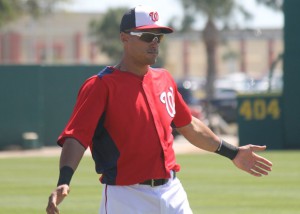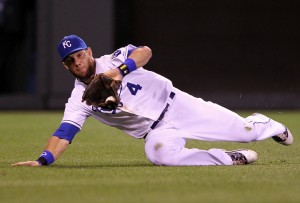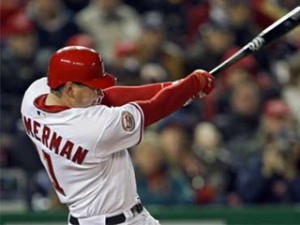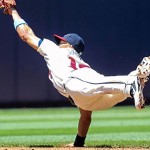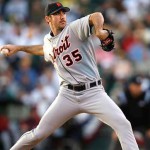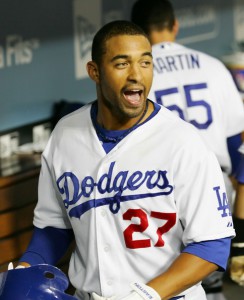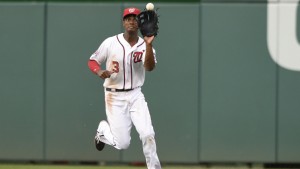
If you don’t know just how good an OF Taylor is … check out the stats below. (AP Photo/Nick Wass via nbcsports.com)
(Note: this is the 2017 version of the “Gold Glove Awards versus Defensive Metrics Review” recurring post that I do each year, even if I havn’t titled it as such thanks to the tie-in to our players).
In Keith Law‘s chat yesterday, someone asked him about his reaction to Gold Glove awards being announced and he said something along the lines of “I have no more Fs to give.”
(btw: someone named “Wally” asked a Nats question at the very beginning … same as our own Wally?)
Anyway, its not hard to understand Law’s stance on the awards: they’re often given more based on reputation than accomplishment on the field, they’re often tied to a player’s offense (inexplicably, since its a defensive award), and we’ve had more than a few ridiculous awards in years past (see Derek Jeter in his waning SS years, or the year Rafael Palmeiro got one for “playing” 1B when he mostly DH’d).
However; the voting has gotten much better the past few years; last year there wasn’t a single Gold Glove award that I thought was “fishy.” Every guy who got an award last year was a deserving winner and you could make a compelling argument for them.
Not this year.
Here’s your 2017 Gold Glove award winners:
In my estimation, more than 50% of these awards went to the wrong player this year. Here’s the guys who I had a problem with:
- Hosmer was actively BAD in the field this year, posting negative range factor and negative DRS figures. Meanwhile Joe Mauer led several defensive metrics for his position.
- Goldschmidt was a deserving winner, but Votto rated better than him across the board in nearly every defensive metric.
- Dozier was behind Kinsler in most every defensive metric as well.
- Longoria was only a slightly bad choice; clearly Todd Frazier was the better AL 3B in totality. I wonder if his mid-season trade hurt him in this regard.
- As we have discussed, Rendon rated 2nd in all of baseball in Fangraphs’ total defense figure, but lost out on reputation to the multi-time award winner Arenado (who did lead the league in DRS fwiw)
- Ozuna also led NL left fielders in DRS … while Adam Duvall led in most every other stat category.
- Our own Michael Taylor nearly had a clean sweep of NL statistical leads … yet lost out to Inciarte on reputation.
- Heyward wasn’t a “bad” pick … but Yasiel Puig outshined him in the statistical category over and over.
- Both Pitchers (not that its that easy to pick them) seemed rather indefensible versus the same two names that kept popping up on leader boards: Dallas Keuchel and R.A. Dickey.
Here’s some quick tables showing all the leading defensive metrics by position for reference:
7 of the 9 non-utility Fielding Bible winners also got Gold Gloves. They gave the P to Keuchel as I thought the gold glove should have gone, and they gave LF to Brett Gardner over Alex Gordon in what was probably a toss-up. But otherwise well done here.
This is the stat that shows that Rendon is the 2nd best defensive player in the game, by the way. And that Taylor was the best CF in the National League, barely trailing Byron Buxton by a tenth of a point.
Just 7 of the 16 GG winners were leaders by this metric, which is either an indictment of the metric or the gold glove selections this year. In case you couldn’t tell, you can guess which picks I trust more.
I like UZR/150; it is the defensive stat I most frequently mention because it is mostly about a player’s range. Generally speaking everyone can hit a ball hit right to them; i want a guy who can make plays out of their “zone.” UZR/150 this year predicted just 5 of the 14 GG winners … but in my estimation identified fully 13 of the 14 most deserving winners. So perhaps my bias shows through here.
DRS did the best job of predicting Gold Glove winners, and predicted 15 of the 18 guys who I “thougth” should have won.
FRAA is Baseball Prospectus’ Fielding Runs Above Average metric and was the worst performing predictor of both actual GG awards and those that I thought should have won. Furthermore it spit out some truly random names (David Freese as leading NL 3B??). So i’d probably put it as the least reliable defensive metric right now.
Technically “Total Zone Total Fielding runs above average” or the “rTOT” Baseball-reference.com stat. It did a decent job predicting the GGs (50%) but also spit out some really random names (Elvis Andrus over Andrelton Simmons??) that make it a bit squirrelly to trust.
So, another year passes of Gold Gloves. None of these defensive metrics are infallible, which is kind of why the three major flavors of WAR often disagree on positional players (each uses a different one of these defensive stats to measure value). But looking across the landscape of the measurements it isn’t hard to see trends and patterns for who was the most deserving at each position.
